Introduction
In the realm of data analysis, the significance of a well-structured date table in Power BI cannot be overstated. As organizations strive to unlock the full potential of their data, time-based calculations become crucial for informed decision-making. A dedicated date table serves as the backbone for executing year-to-date totals, period comparisons, and trend analyses, addressing the common pitfalls of report creation and data inconsistencies.
By implementing practical strategies and leveraging DAX functions, users can enhance their analytical capabilities, leading to clearer insights and more efficient operations. This article delves into the essential steps for creating and optimizing date tables, equipping professionals with the tools needed to transform their data into actionable intelligence.
Understanding the Importance of Date Tables in Power BI
In Power BI, having a dedicated date table dax structure is not only advantageous; it is crucial for performing time-related calculations such as year-to-date (YTD) totals, period comparisons, and trend analysis. By establishing a year-to-date hierarchy within your date table, you can significantly optimize space and enhance your model’s performance, directly addressing common challenges like time-consuming report creation and information inconsistencies. Without this structured approach, users may encounter substantial limitations in their analysis capabilities, leading to confusion and mistrust in the information presented, often exacerbated by a lack of governance strategies.
For practical application, Xiaoxin has requested a pbix file with sample data for testing, facilitating hands-on experience in utilizing these features effectively. Additionally, users often face challenges, as illustrated by Paul’s experience with formula errors, highlighting the importance of proper implementation:
“I’m also entering the formula you provided and substituting Sheet1 for Office Stats – I assume that’s the right way? Once it’s entered, I’m getting an error message at the bottom: ‘Token Eof expected.’
Any thoughts on that?”
A well-constructed schedule matrix that incorporates a date table dax serves as the backbone of your reporting framework, supporting various time intelligence functions that enable precise filtering and calculations across different visualizations. This foundational element is vital for overcoming challenges in leveraging insights from Power BI, ensuring that documents are not only filled with numbers and graphs but also provide clear, actionable guidance.
Additionally, the case study titled ‘Calculating Summary Statistics in Power BI’ illustrates how calendar records can be employed effectively, preparing for conducting statistical analysis. By utilizing a timeline resource, users can access a thorough perspective of time-related metrics, resulting in more insightful analyses that promote informed decision-making, ultimately improving operational efficiency.
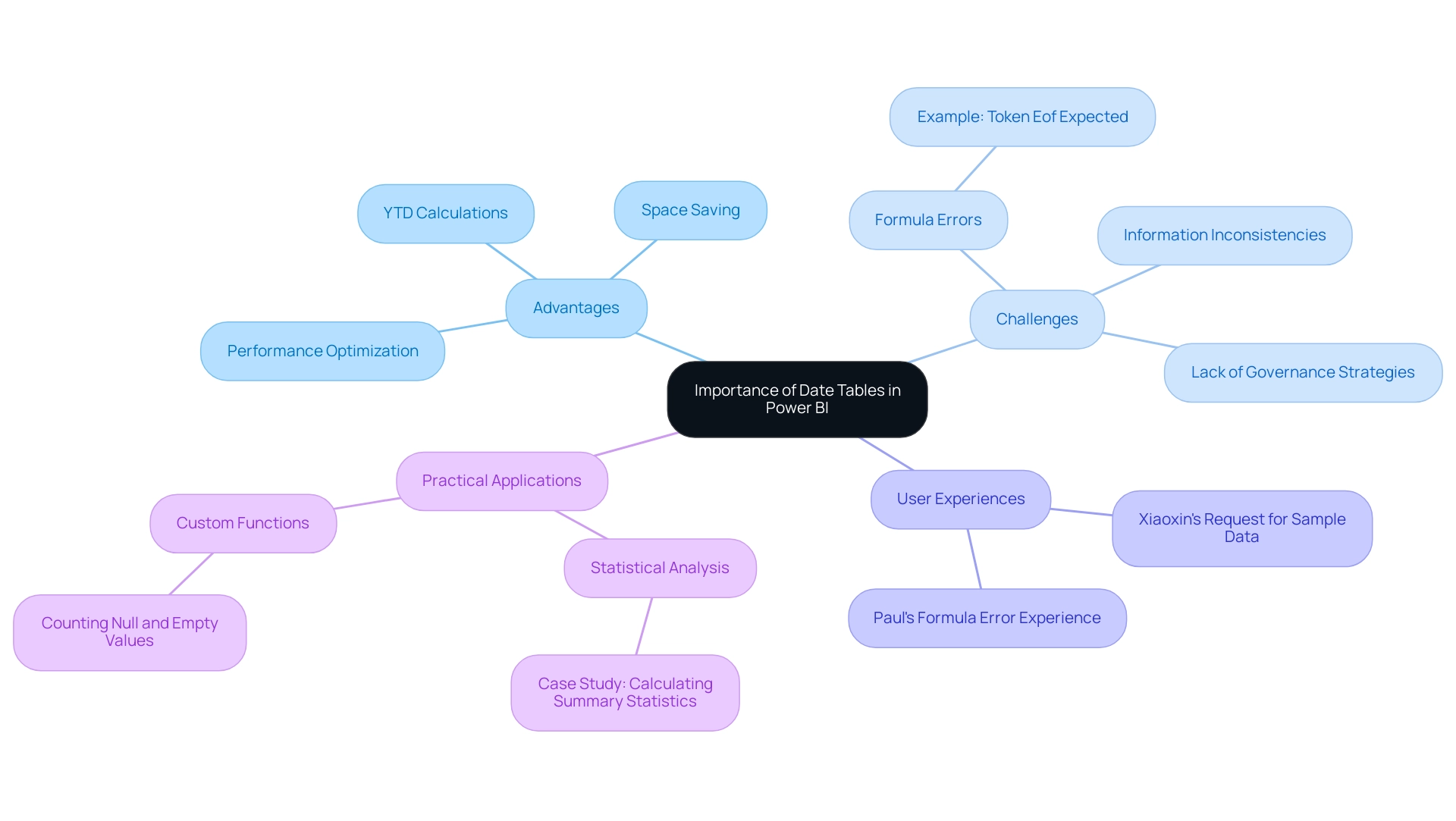
Step-by-Step Guide to Creating a Date Table Using DAX
Establishing a date table DAX in Power BI is not only a powerful method to enhance your analysis capabilities but also a crucial step in tackling common challenges like time-consuming report creation and inconsistencies. Each step outlined below directly contributes to overcoming these challenges and provides actionable guidance for effective insights:
-
Open Power BI Desktop: Start by launching the application and navigating to the ‘Data’ view. This initial step ensures you are in the right workspace to manage your information effectively.
-
Create a New Table: In the ‘Modeling’ tab, select ‘New Table’. This action opens a formula bar for you to input DAX expressions, allowing you to customize your data structure to meet reporting needs.
-
Input the DAX Formula: To generate a date range, enter the following DAX formula:
DAX
date table = CALENDAR(MIN(YourDataTable[YourDateColumn]), MAX(YourDataTable[YourDateColumn]))
Make sure to replace YourDataTable and YourDateColumn with the relevant names from your dataset. This formula addresses inconsistencies by ensuring the time range is accurately captured from your dataset.
- Add Extra Columns: Enhance your timeline by incorporating columns for year, month, quarter, and more. Use these DAX formulas:
- Year:
Year = YEAR(date table[Date]) - Month:
Month = FORMAT(DateTable[Date], "MMMM") - Quarter:
Quarter = QUARTER(DateTable[Date])
These additional columns provide a structured way to analyze data over time, making it easier to derive actionable insights from reports.
-
Label as Time Structure: After your time structure is established, make sure you label it correctly by selecting ‘Label as Time Structure’ in the ‘Modeling’ tab and choosing the appropriate time column. This step is crucial for Power BI to comprehend how to use the time structure effectively in calculations and visualizations, thereby supporting information governance.
-
Use in Reports: Once your calendar structure is established, utilize it in reports for effective time-based analysis. Drag and drop fields from your temporal dataset into your visualizations to filter and segment data based on time, thus providing clearer, actionable insights.
For example, utilizing the calendar resource enables stakeholders to swiftly recognize trends over particular intervals, resulting in informed decision-making.
Case Study: Cloning a Date Table
In scenarios where you may need to create a new date table for a role-playing dimension, consider cloning an existing date table. This can be accomplished by creating a calculated dataset that references the original. While the new furniture will have the same columns, it will not carry over model properties such as formats or hierarchies, which is essential to keep in mind.
By following these steps, you will successfully create a robust date table dax in Power BI, enabling you to perform advanced time-based analytics and significantly improve your documentation capabilities, alleviating the challenges of generating outputs and information governance. Remember, a robust governance approach is essential for maintaining information integrity and reliability in your documents. Thanks for reading!
Also, keep in mind that the DAX query view now supports multiple query tabs that can be renamed or removed, offering a more streamlined experience while working with your information.
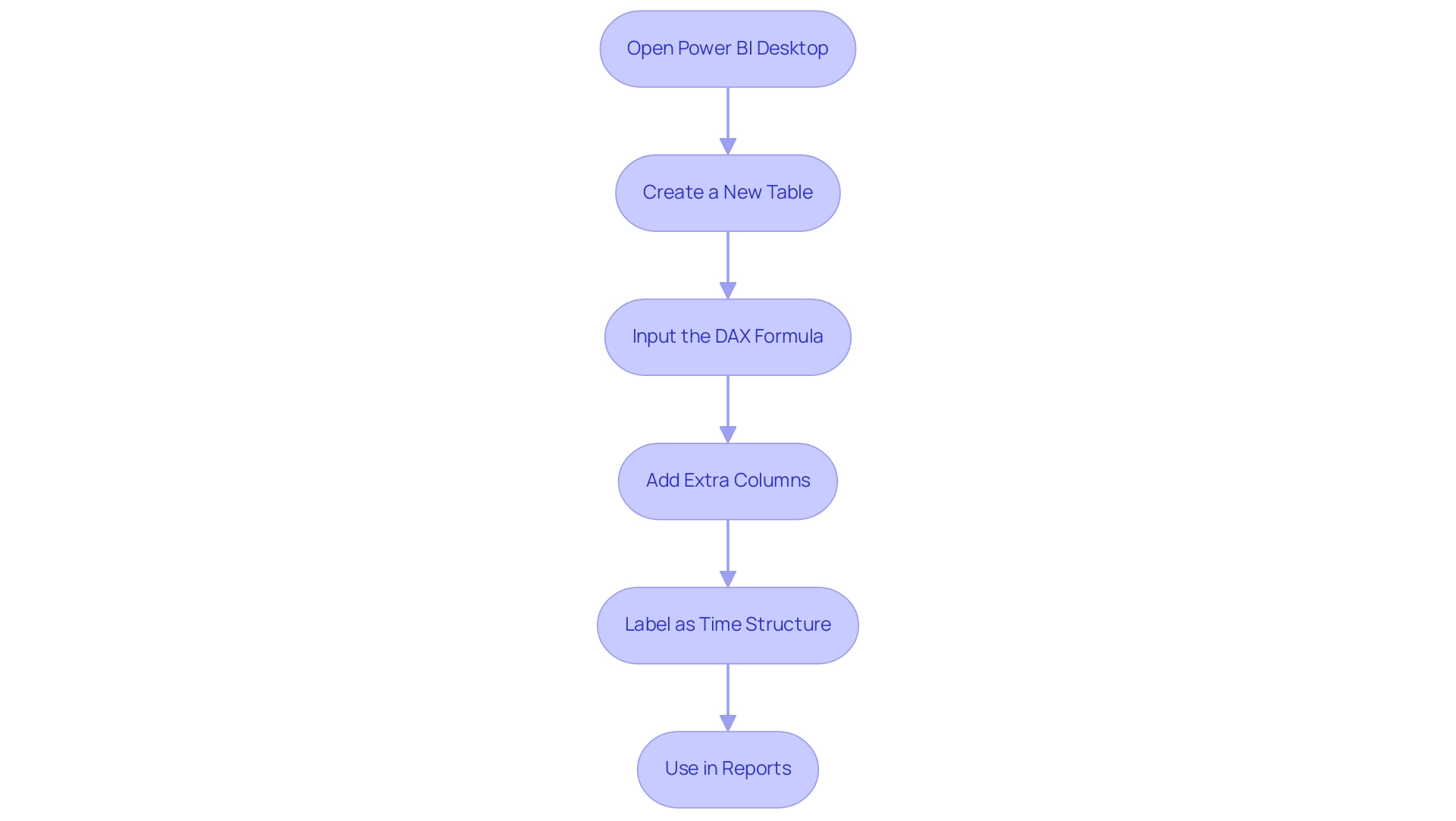
Enhancing Your Date Table with Additional Attributes
Enhancing your date table DAX in Power BI can significantly improve the depth of your analysis and address common challenges like time-consuming report creation and inconsistencies. Consider integrating the following attributes to enrich your datasets:
- Fiscal Year: If your organization follows a fiscal calendar, adding a fiscal year column is essential.
You can implement this with the following DAX formula:
DAX
Fiscal Year = IF(MONTH(Date Table[Date]) >= 7, YEAR(Date Table[Date]) + 1, YEAR(Date Table[Date]))
This formula assumes that the fiscal year begins in July, helping you align your data analysis with fiscal reporting requirements. As noted by Venesectrix, having the ability to recalibrate summary statistics is crucial when summarization requirements change, emphasizing the need for accurate fiscal year calculations.
- Week Number: For weekly information analysis, it’s beneficial to include a week number column.
This can be accomplished using:
DAX
WeekNumber = WEEKNUM(DateTable[Date])
This allows for easier aggregation and insights on a weekly basis, adapting to various reporting needs while ensuring a streamlined approach to data analysis.
- Holiday Flags: Identifying holidays can add significant context to your analyses. You can create a column that flags specific dates as holidays with this formula:
DAX
IsHoliday = IF(DataTable[Date] IN {DATE(2023, 1, 1), DATE(2023, 12, 25)}, TRUE(), FALSE())
Adjust the dates in the curly braces to reflect your organization’s holidays, enabling quicker adjustments in your reporting processes and providing clearer guidance for decision-making.
Additionally, it’s important to consider the statistics created due to AUTO_CREATE_STATISTICS, which are named with a prefix of _WA.
Properly created statistics can significantly enhance query performance by providing the optimizer with precise distribution information. A case study on generating statistics demonstrates how single-column statistics, created using default options that sample 20 percent of the dataset, can enhance query performance. By incorporating these additional attributes, your date table DAX will serve as a more powerful tool for generating meaningful insights from your information.
This enhancement not only aids in accurately tracking performance but also aligns your analyses with key business metrics, ultimately supporting informed decision-making and addressing the recurring challenges faced in document creation. Moreover, utilizing Business Intelligence tools can convert these raw insights into strategic actions, while RPA can automate repetitive tasks in document generation, enhancing overall efficiency and information accuracy.
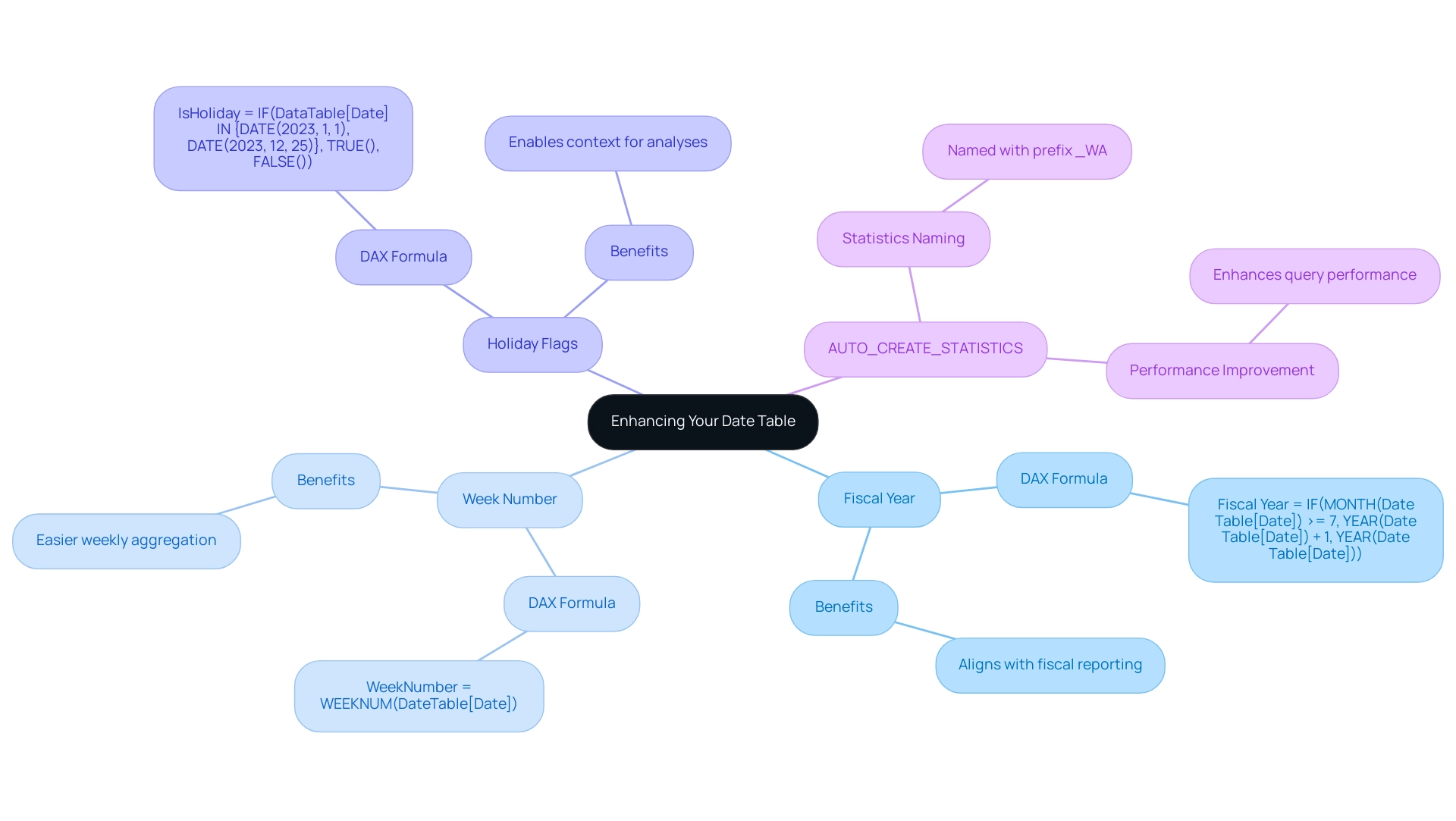
Utilizing Time Intelligence Functions with Your Date Table
After creating your date table DAX, which is a prerequisite for utilizing most time intelligence functions, harness the power of DAX with various time intelligence functions to elevate your analytical capabilities. These functions not only streamline your reporting process but also align with Business Intelligence goals to enhance operational efficiency. By integrating DAX functions, you can effectively tackle challenges such as time-consuming documentation creation and information inconsistencies, which are common in technology implementation.
Here are essential examples for effective reporting:
-
Year-to-Date (YTD) Calculation: To compute YTD sales, utilize the following DAX formula:
DAX
YTDSales = CALCULATE(SUM(Sales[Amount]), DATESYTD(DateTable[Date]))
This function aggregates sales from the beginning of the year to the current date, providing valuable insights into overall performance and driving growth through data-driven decision-making. -
Month-to-Date (MTD) Calculation: For tracking MTD sales, apply this formula:
DAX
MTDSales = CALCULATE(SUM(Sales[Amount]), DATESMTD(Date Table[Date]))
It enables you to analyze sales figures from the start of the month, allowing for timely adjustments and strategy refinements, thus addressing common challenges in report creation and data inconsistencies. -
Prior Year Comparison: To evaluate sales against the previous year, implement this DAX function:
DAX
PriorYearSales = CALCULATE(SUM(Sales[Amount]), SAMEPERIODLASTYEAR(Date Table[Date]))
This comparison highlights trends and shifts in performance, empowering you to make informed decisions and tailor strategies according to historical data insights.
These time intelligence functions facilitate the creation of dynamic reports that adapt based on date contexts, enriching your analysis and enhancing reporting accuracy. Additionally, users can navigate temporal hierarchies (day, month, quarter, year) for deeper analysis, as demonstrated in the case study titled ‘Comparing Performance Across Temporal Hierarchies.’ Furthermore, by implementing RPA solutions, you can automate the reporting process, addressing repetitive tasks and freeing your team to focus on strategic initiatives.
Finally, remember that email and print options for sharing content are also provided, enhancing the usability of insights derived from these calculations.
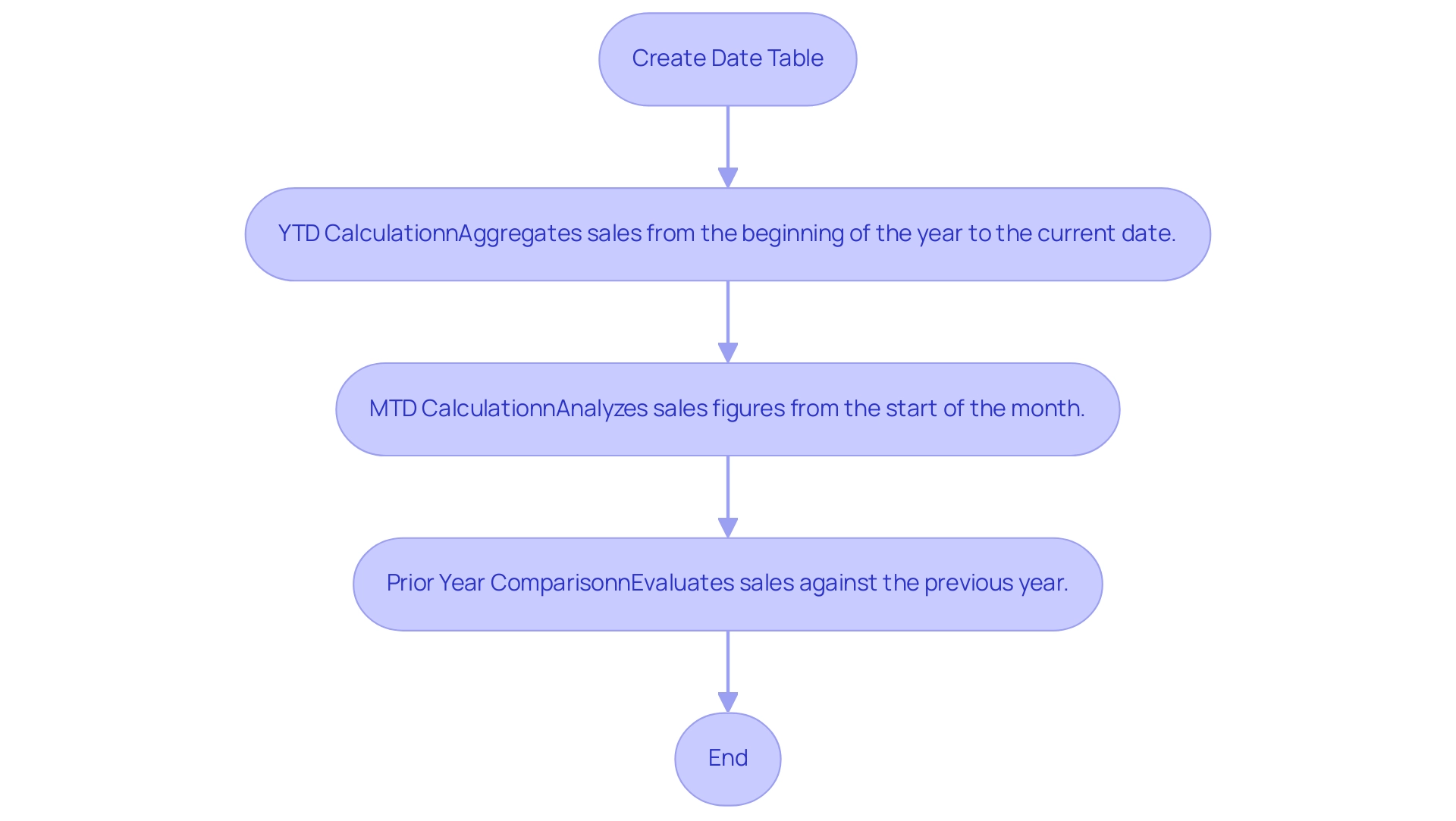
Best Practices for Maintaining Your Date Table
To maximize the effectiveness of your time series in Power BI and enhance your organization’s data-driven insights, implementing the following best practices is essential:
-
Frequent Refreshes: Consistently revise your timeline framework in reaction to alterations in your information model or the necessity to include new time spans. Proactively ensuring your analysis remains relevant and precise is vital in today’s information-rich environment, where unlocking the power of Business Intelligence can prevent competitive disadvantages.
-
Remove Unused Columns: Conduct periodic reviews to identify and eliminate any columns that are no longer necessary. This practice not only helps maintain a streamlined model but also enhances efficiency and performance—key aspects when leveraging RPA solutions to automate repetitive tasks and reduce task repetition fatigue.
-
Document Changes: Maintain a comprehensive log of modifications made to the calendar’s structure and attributes. This documentation offers clarity for future users and monitors the evolution of the model, supporting informed decision-making that drives growth and innovation.
-
Optimize Performance: Continuously monitor the performance of your date table within the information model. Implement adjustments as needed to minimize loading times and improve calculation efficiency. Accurate histograms are crucial for columns with highly skewed information distribution, particularly in WHERE clauses, as they significantly enhance query performance. As emphasized in the challenges of utilizing insights from Power BI, such as time-consuming documentation creation and information inconsistencies, strategic performance management is essential. RPA solutions can aid in automating preparation processes, significantly reducing the time spent on report generation and enhancing accuracy.
-
Backup and Restore of Statistics: Before gathering new statistics, consider backing up the original ones. This precaution allows for quick restoration in case performance issues arise, ensuring that any negative impacts from new statistics can be swiftly addressed. The importance of having a fallback plan in performance management is underscored by the case study on the backup and restore of statistics, which can prevent inconsistencies in reporting.
By adhering to these best practices, your date table DAX will remain a robust asset for data analysis, delivering precise insights that support your organization’s adaptation and growth in a competitive landscape.
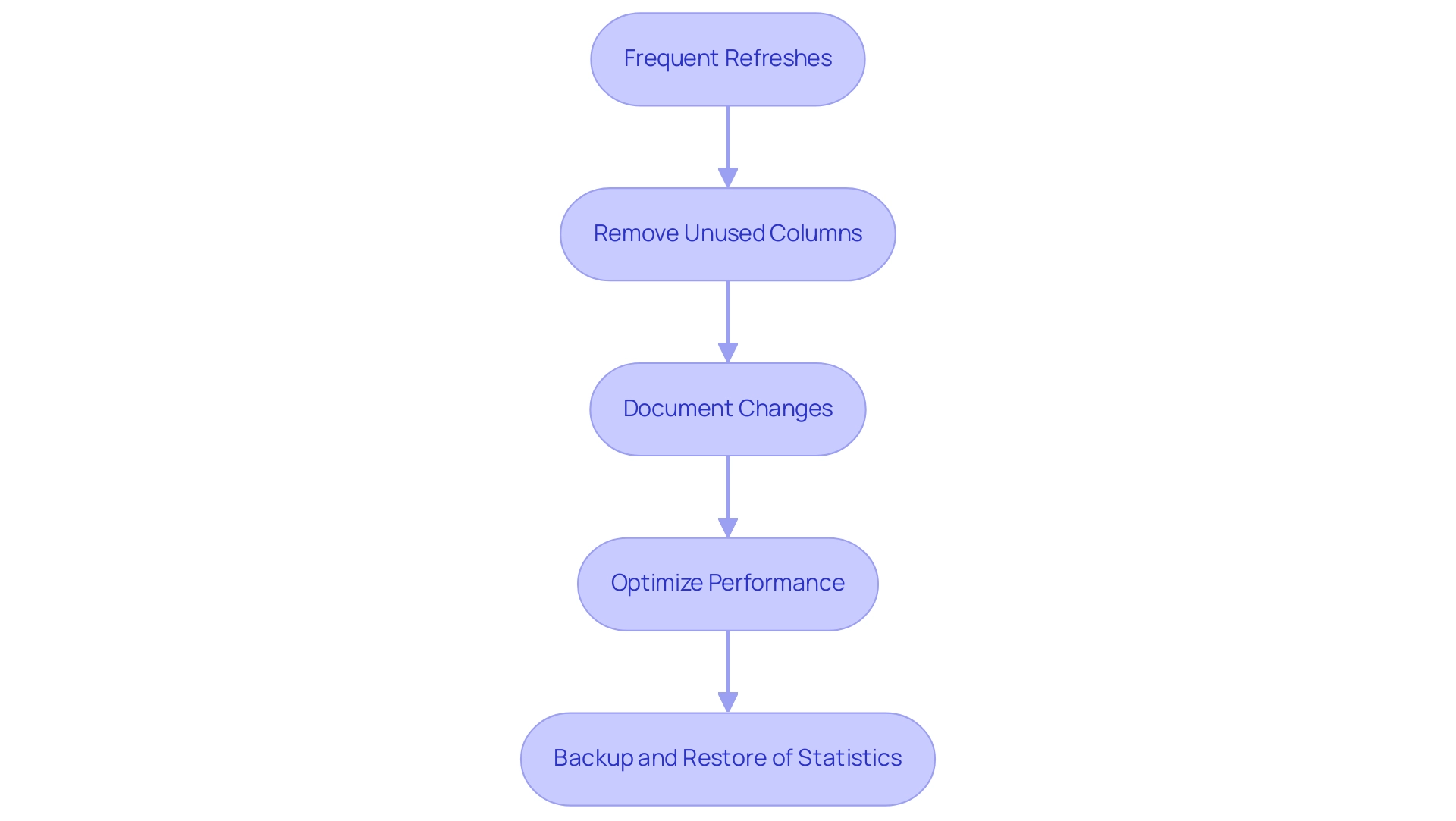
Conclusion
A well-structured date table is fundamental to harnessing the full power of data analysis in Power BI. Throughout this article, the critical importance of creating and optimizing date tables has been emphasized, showcasing how they serve as the backbone for essential time-based calculations. By implementing DAX functions and integrating additional attributes like fiscal years and holiday flags, users can significantly enhance their analytical capabilities, leading to clearer insights and informed decision-making.
The step-by-step guide provided illustrates the practical strategies needed to create a robust date table, address common challenges such as data inconsistencies, and streamline report creation. Furthermore, the importance of maintaining and regularly updating this table ensures that it remains a reliable resource for generating meaningful insights over time. Best practices such as optimizing performance and documenting changes are vital to sustaining the effectiveness of the date table in evolving data environments.
In summary, leveraging a well-constructed date table not only improves operational efficiency but also empowers organizations to transform raw data into actionable intelligence. By embracing these strategies, professionals can overcome obstacles in data analysis, ensuring that their reporting processes yield accurate and actionable insights that drive strategic growth and success.

